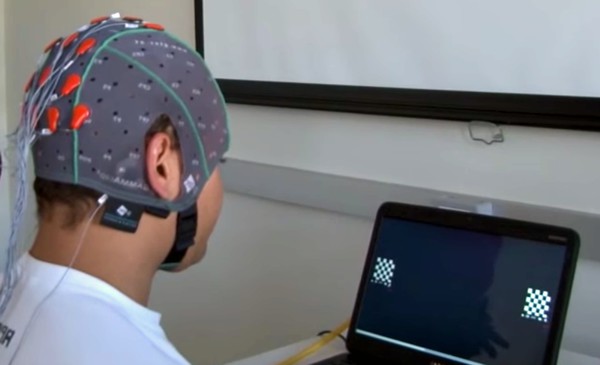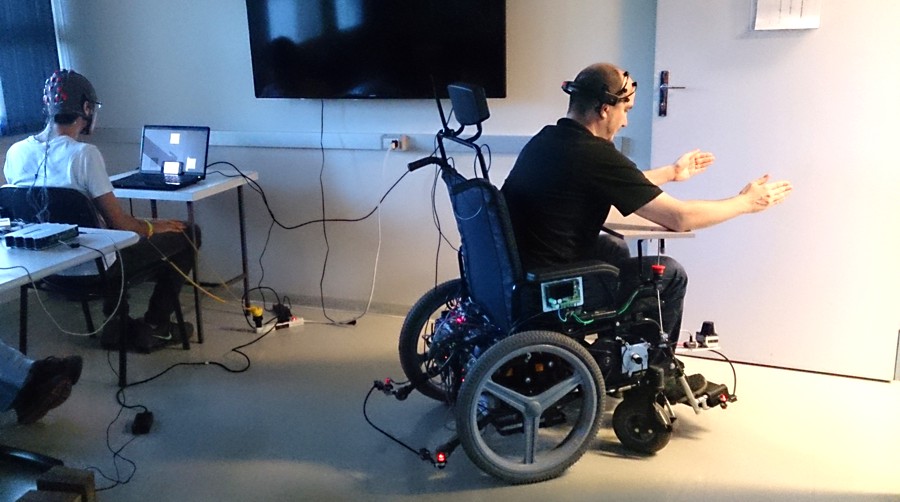
July 20th, 2015 Text by WebContent
Strokes are the leading cause of death and disability in Brazil, affecting about 70,000 people every year. Therefore, researches that aim to give a better life quality to stroke patients are extremely important. One of them is being developed by BRAINN: a robotic and intelligent wheelchair that can be controlled by brain signals.
The project began in 2010 under the DesTINe (Development of Information Technology for Neurology) project, supported by FINEP, and continues now with BRAINN. The idea is to use Brain-Computer Interface (BCI) technology for the development of a wheelchair specially designed to assist stroke patients and people who have movement impairments.
Can you imagine a wheelchair that can be “driven” by the brain? Or through little movements of the head or facial muscles? For many, that may sound like science fiction. But inside the BRAINN laboratories these amazing technological advances are becoming a reality.

Brain signals are captured by electrodes in a special cap and converted into commands, which then can be used to move objects.
BCI = Brain-Computer Interface
BCI is a system that allows one to control devices via brain signals. In the wheelchair case…
- First, there is the detection of the brain’s electrical signals (via electrodes, for example);
- Then these signals are converted into digital data and interpreted by a computer;
- The computer transmits the information to an equipment (such as a wheelchair), making it move.
HOW IS IT POSSIBLE TO USE BRAIN SIGNALS TO CONTROL OBJECTS?
In order to detect brain signals, several different techniques may be used. The limiting factor is which ones can be safely equipped in the wheelchair. MRI is an option. It can produce 3D images of the brain and is very accurate, but quite impractical since it is not portable. Electroencephalography (EEG) is the better option, currently being widely studied by the group. It is portable and capable of capturing the brain’s electrical signals on the go.
One of the tests performed with EEG in remotely controlling devices took advantage of involuntary reactions that we have when we look at flashing lights.
“When you see a light flashing at a certain frequency, our occipital cortex – part of the brain that processes visual stimuli – responds with a signal that oscillates in the exact same frequency and can be detected by EEG,” explains Gabriela Castellano, BRAINN researcher. “The tests made by researcher Romis Attux and his team consisted of placing flashing lights with different frequencies and associating the frequency of each one of them to a movement control in a little toy car. That way, when the person was looking at one of the lights, the car moved backwards, and when the person looked at the other light, the car moved forward”.

Equipment that permits brain singal capturing. Click the image to watch a video on how BCI was used to control the red car.
A more developed version of this system is currently being used in experiments with the wheelchair. Commands like “turn right” or “turn left” are associated with different frequencies of light and, after the observation of the light patterns, the user’s brain signals are interpreted by a computer and sent to the chair, which moves accordingly.
The processing of brain signals is made by a software developed by doctoral students Thiago Bulhões and Sarah Negreiros, from the team of BRAINN researcher Romis Attux, of the Faculty of Electrical Engineering and Computing, of Unicamp. The program’s algorithms eliminates noise and provides information about the quality of the signals. After this processing, the information is wirelessly sent to the wheelchair, enabling remote control.
‘SMART’ WHEELCHAIR MAKES NAVIGATION EASIER
In this project, developing new robotic techniques is as important as studying the brain. The wheelchair used in BRAINN’s research is not an ordinary equipment: it has several electronic sensors that, once linked to innovative algorithms, make it “smart” and easier to use and navigate.
Works in robotics are the specialization of BRAINN’s researcher Eleri Cardozo and the group he coordinates. The lab’s aim is to make the control of the devices easier by people with movement difficulties. As an example of the group’s advances, researcher Leonardo Olivi’s improvement of an assisted navigation algorithm was awarded with the Best Paper prize at the 10th International Conference on Ubiquitous Robots and Ambient Intelligence, in South Korea. With the help of the algorithm, robots can make better use of their sensors to “understand” the environment around them, making automatic course corrections, for example, while being navigated by a person.

BCI test at the BRAINN labs. The user on the left observes the flashing lights, his brain signals are captured and analysed by the group’s software and are, then, sent wirelessly to the wheelchair.
Combining these various multidisciplinary projects, BRAINN is developing a robotic wheel chair that becomes smarter by the day. The machine employs robotics and mathematical models to avoid accidents, independently of brain signals, and has many sensors that capture information around it – such as shock detectors and lasers that sweep the front of the chair to detect steps – providing valuable data to improve the equipment’s control.
CONNECTING BRAIN AND MACHINE
While BRAINN researchers improve the BCI system and the smart wheelchair, there is work already underway to ensure that both are integrated in harmony.
“Both the chair and the strobing lights system were tested separately with success,” says Castellano. “In the upcoming months, we will integrate the two systems and test the operation of the wheelchair by BCI. Moreover, other strategies for capturing brain signals – ones that do not use flashing lights – are also being tested “.
There is still much work ahead for the scientists developing the smart wheelchair. Nevertheless, the early results are promising. In every stage of development, new technologies are created and improved, expanding the possibilities of what the wheelchair is able to do. Observing a wheelchair being operated remotely by capturing brain signals is a fascinating experience. It exemplifies the high potential of Brazilian Science to advance the boundaries of knowledge and improve the life quality of those who suffer the consequences of a stroke and have movement difficulties.





 Português do Brasil
Português do Brasil